Op-ed
A return to source: Saving the Witwatersrand’s ancient freshwater system to save South Africa’s rivers
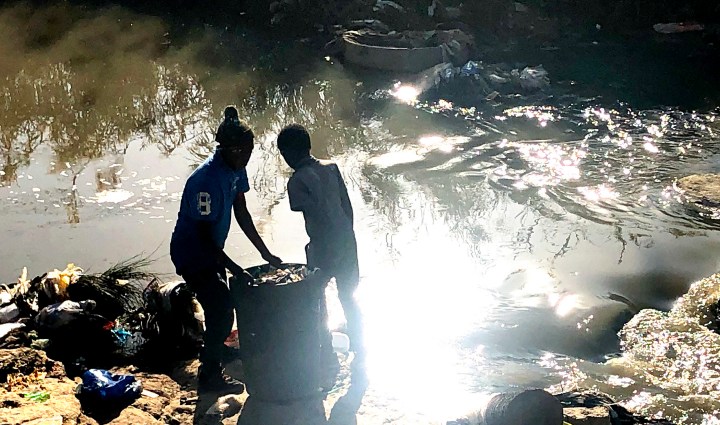
A freshwater sanctuary connecting Gauteng’s water source areas, incorporating the last natural ridges and connecting reserves through riverine corridors, is needed to protect the Witwatersrand’s freshwater resources. These resources are in danger of permanent destruction due to South Africa’s waterborne sewerage system.
A network of perennial fountains, springs and waterfalls
The Witwatersrand in Gauteng is home to one of South Africa’s major wetland systems and the origin of its largest rivers — yet this fact is not widely or commonly known. Its ancient and magnificent freshwater system consisting of a network of perennial fountains, springs and waterfalls is seldom mentioned or acknowledged nowadays.
Keeping the public ignorant of it saves government embarrassment and the need to take action. Decades-long pollution and abuse can continue without accountability, so there’s no need to divert funding to the restoration of the freshwater system. Widespread ignorance of these priceless assets of the people has contributed to municipalities being able to continue their massive pollution without a public outcry.
The Witwatersrand, meaning “ridge of white waters” in Afrikaans, gets its name from the appearance of the waterfalls and streams shimmering on the distinctive white quartzite rocks of the ridge when the first white settlers arrived in the area. The ridge is a 56km-long, north-facing scarp over which several north-flowing rivers form waterfalls. The east-west-running scarp, situated on the continental divide, can be traced from Bedfordview in the east, through Johannesburg and Roodepoort, to Krugersdorp in the west.
One of South Africa’s largest wetland systems emanates from this plateau. Streams flow in all directions to form catchments around Johannesburg.
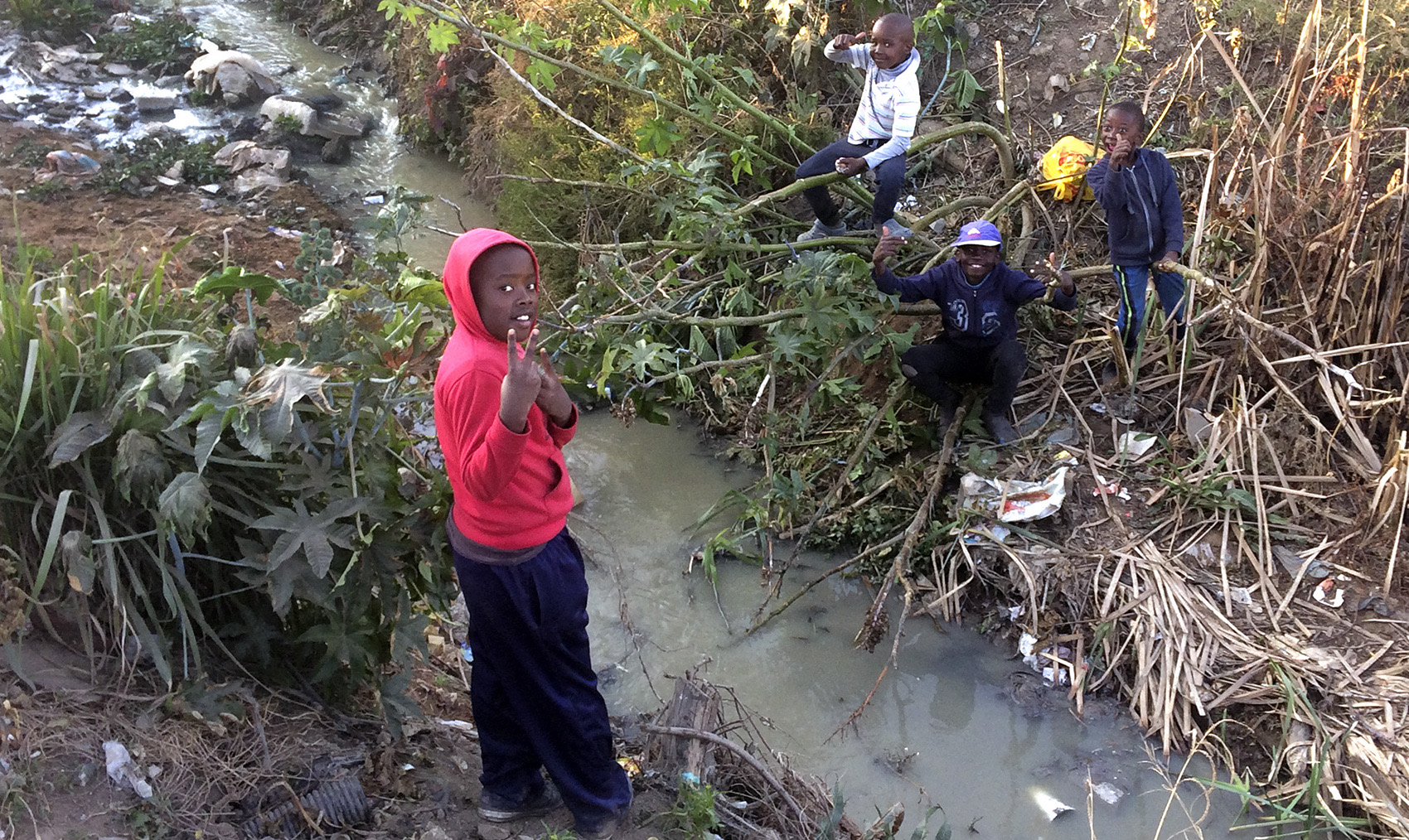
Children grow up playing in the sewage, Kalspruit, Gauteng. (Photo: Willem Snyman)
The Jukskei drains the northern slope, the Hennops the eastern, the Crocodile the western and the Klip River the southern. The first three form the headwaters, or upper flow system, of the Limpopo River, while the last forms the headwaters of the Vaal-Orange system to the south.
The wetland system has its origins in the ancient Witwatersrand sea which formed in the Witwatersrand basin, a depression from a failed rifting event. A shallow sea of first life, it was home to the first stromatolites, which in their fossilised form provide records of ancient life on Earth dating back to around 2.5 billion years ago.
The Witwatersrand basin formed the Cradle of Humankind. This healthy permanent freshwater system nurtured our first ancestors, the early Hominini, living around the Cradle for many millions of years.
After drying up, this ancient seabed eroded over millions of years to form caverns inside the sedimentary substrate. Large amounts of water are still stored in this interconnected dolomitic karst system. Some estimates are that 40% of our country’s freshwaters are found here. They are all highly sensitive to permanent pollution.
This abundance of underground water formed an ancient river system that has given life to this subcontinent over the ages. In a significant coincidence the Witwatersrand basin also later formed the Cradle of Humankind. This healthy permanent freshwater system nurtured our first ancestors, the early Hominini, living around the Cradle for many millions of years.
These waters are still flowing to this day and sustain our nation. Millions of people’s lives depend upon them for drinking and irrigation, as do countless animals living along these last natural corridors. They are also vital to the health of the subcontinent.
Gold mining and the damage done
The Witwatersrand also contained the largest concentration of gold on earth, yielding a third of all the gold ever mined. This gave rise to the founding of Johannesburg, South Africa’s largest metropolis, in 1886. One of the highest-positioned cities in the world, it is often said to be one of the world’s few large cities not built near a river. In fact, it was built right on top of the wetland sources and headwaters of four large rivers — the Crocodile, Limpopo, Vaal and Orange rivers.
The mining houses abused some of the Witwatersrand’s most precious freshwaters. Some aquifers were pumped dry to stop them from flooding in an underground war with water. Fountains were capped with concrete, wetlands laid dry and diverted into stormwater pipes. The mining houses made fortunes from gold mining, but neglected the rehabilitation of the streams, leaving behind sludge dams and acid mine drainage.
In some places, all that remains of these waters is the memory of fountains as referenced in Gauteng place names like Braamfontein, Doornfontein and Randfontein.
Some beautiful parks were also created around the streams, but many are now polluted, abandoned and in disrepair.
The horror of waterborne sewerage
Tragically, Gauteng’s ancient springwater streams have in recent decades also been enslaved as “working rivers” by being treated as open sewerage and solid waste disposal systems. Billions of tons of plastic and sewage have been dumped into the water, saving on treatment costs only to cause untold environmental damage.
The main polluters are municipalities, with their poor waste removal services, bad sanitation and chronically malfunctioning wastewater treatment works. Country-wide most of them are not functioning properly despite the billions of rands being pumped into them. Political deployments of individuals without adequate skills to management positions have brought this previously well-functioning system to its knees.
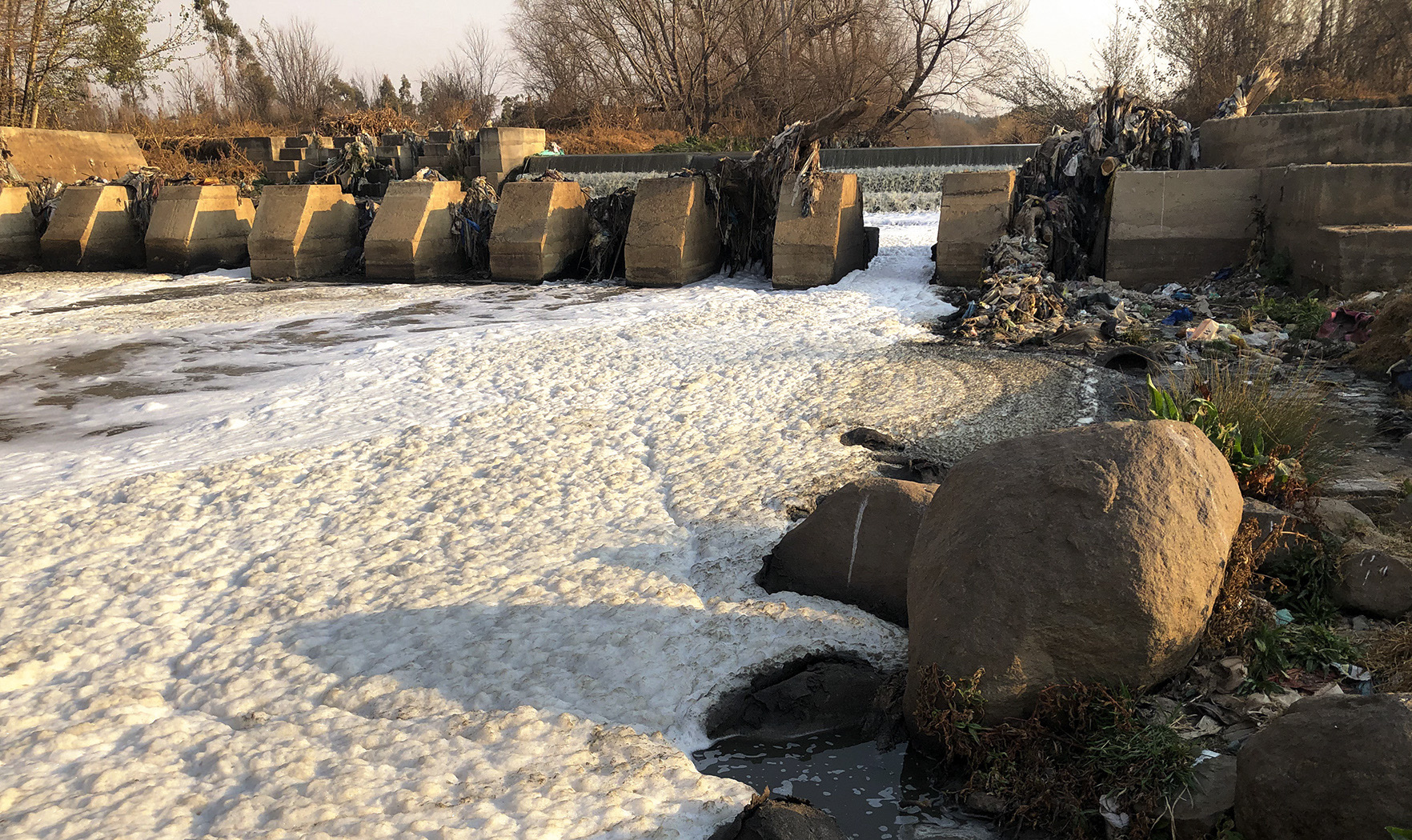
The ARC weir in Irene , below the Olifantsfontein WWTW. This treatment works is mostly still in denial, and ascribe this foaming to ‘turbulence’. When this foam dissipates it leaves thick black tar encrustations, which clearly shows it to be sewage sludge from improper treatment, along with raw- sewage from failing sewerage infrastructure in the densely populated areas at the source. (Photo: Willem Snyman)
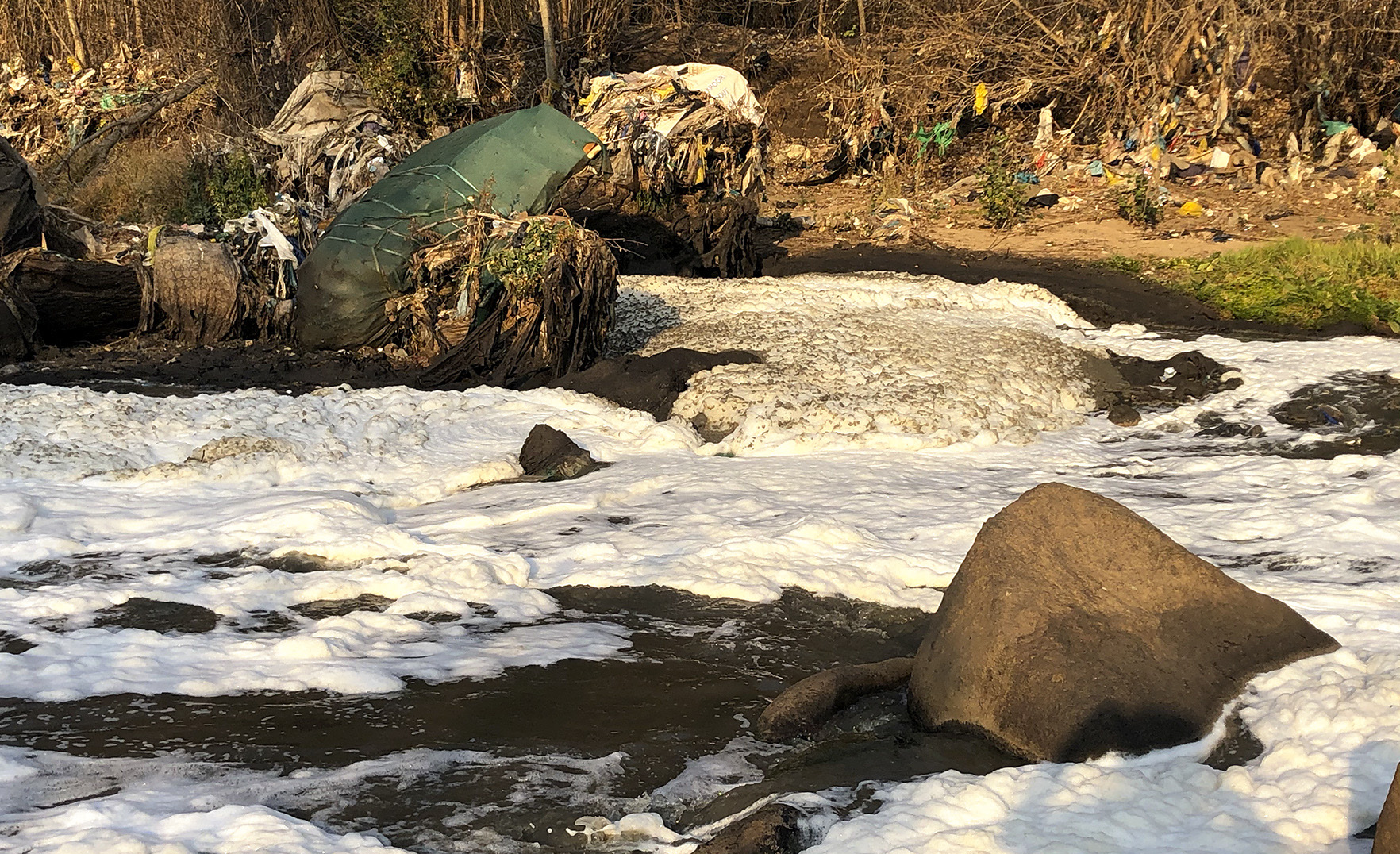
Sewage foam and plastic at the ARC weir in Irene, Gauteng. Situated a few kilometers below the Olifantsfontein WWTW of Erwat – one of the major pollution sources of the Hennops River. Most of the natural life has been wiped out in a silent ecocide of zillions of creatures in the last five years. (Photo: Willem Snyman)
Our rivers and the environment have to bear the brunt of this failure, as all outlets of the treatment works discharge into our rivers and some directly into the sea.
Failing sewerage infrastructure, especially in informal areas, are the largest cause of pollution at source. Sewage pipes are blocked (mostly with nappies) which causes them to overflow, making them a health hazard to local communities.
Apocalyptic
This problem has quietly unleashed pollution on an apocalyptic scale from the heart of Gauteng onto the whole country, and it has grown in severity over the past decade.
Most of this life was systematically exterminated in a silent ecocide, starting with cyanide from gold extraction to the sewage effluent from our largest metros.
Our largest river systems are being terminally polluted at source by vast amounts of waste, surreptitiously flushed away for many years. This waste also pollutes neighbouring countries, as the Limpopo forms our border with Botswana and Zimbabwe before flowing right through Mozambique, and the Orange is our border with Namibia.
These rivers used to teem with aquatic life, from mussels, crabs and fish to otters. Gene pools in these ancient rivers stretched back millions of years. Most of this life was systematically exterminated in a silent ecocide, starting with cyanide from gold extraction to the sewage effluent from our largest metros. Billions of creatures have been killed off, their habitats completely destroyed, and even hardy indigenous trees are dying.
Vaal River disaster
The Vaal River — Gauteng’s major water “artery” — is a national disaster, with the pollution levels of the water a threat to the safety of residents’ drinking water. The SA National Defence Force was even deployed to restore the system in 2018, to no avail.
On the other side of the continental divide the Jukskei, Hennops, Crocodile and Apies rivers, which form the main sources and headwaters, or upper flow systems, of the Limpopo are in an even more dire state.
Most of these rivers are also highly eutrophic, which means that their water has been progressively enriched with minerals and nutrients. This causes an overgrowth of blue-green algae, also called cyanobacterial blooms, which can contain deadly microcystins, which are so minuscule that they can’t be filtered out. These toxins can even kill large animals like elephants.
Spread of toxins
These eutrophic rivers all feed the large outlying irrigation dams that surround Johannesburg. Much of their water ends up in the Hartbeespoort Dam, adding to the eutrophication of our most polluted water body. This water is sprayed onto our edible crops, thus introducing toxins and microplastics to consumers through their food and water in a sickness-inducing cycle.
Numerous pathogens are associated with raw sewage. Deadly viruses and bacteria like those causing cholera and hepatitis[1] can survive in the rivers for extended periods, which pose a grave danger to all of those living around them and downriver.
Raw or improperly treated sewage and industrial effluent also contain a cocktail of other harmful chemical substances, such as persistent organic poisons, hormones, endocrine disruptors and medical waste like antiretrovirals. Many of these substances bioaccumulate in animals and build up in the food chain. Even when wastewater treatment works are functioning properly, these substances are neither removed nor monitored.
Plastic waste for Africa
Added to this scenario is plastic pollution on a vast scale, mostly from disposable household articles. Over the rainy season, millions of tons of plastic are washed down to rivers and ultimately to the sea. All of these will continue to break down into microplastics — virtually immortal toxic particles which will continue to harm all life forms for the next five hundred to a thousand years. They are already inside all humans and in most creatures. A recent study has even found microplastic particles in the placentas of unborn babies.
The proliferation of these plastics is largely the result of poor or non-existent solid waste removal in low-income areas around the source streams.
This is the hidden shame of our mass consumerist society, which no one is willing to acknowledge.
Plastic should be reclassified as hazardous waste and treated as such. It should be kept out of our waters, as it never leaves the system once it gets in.
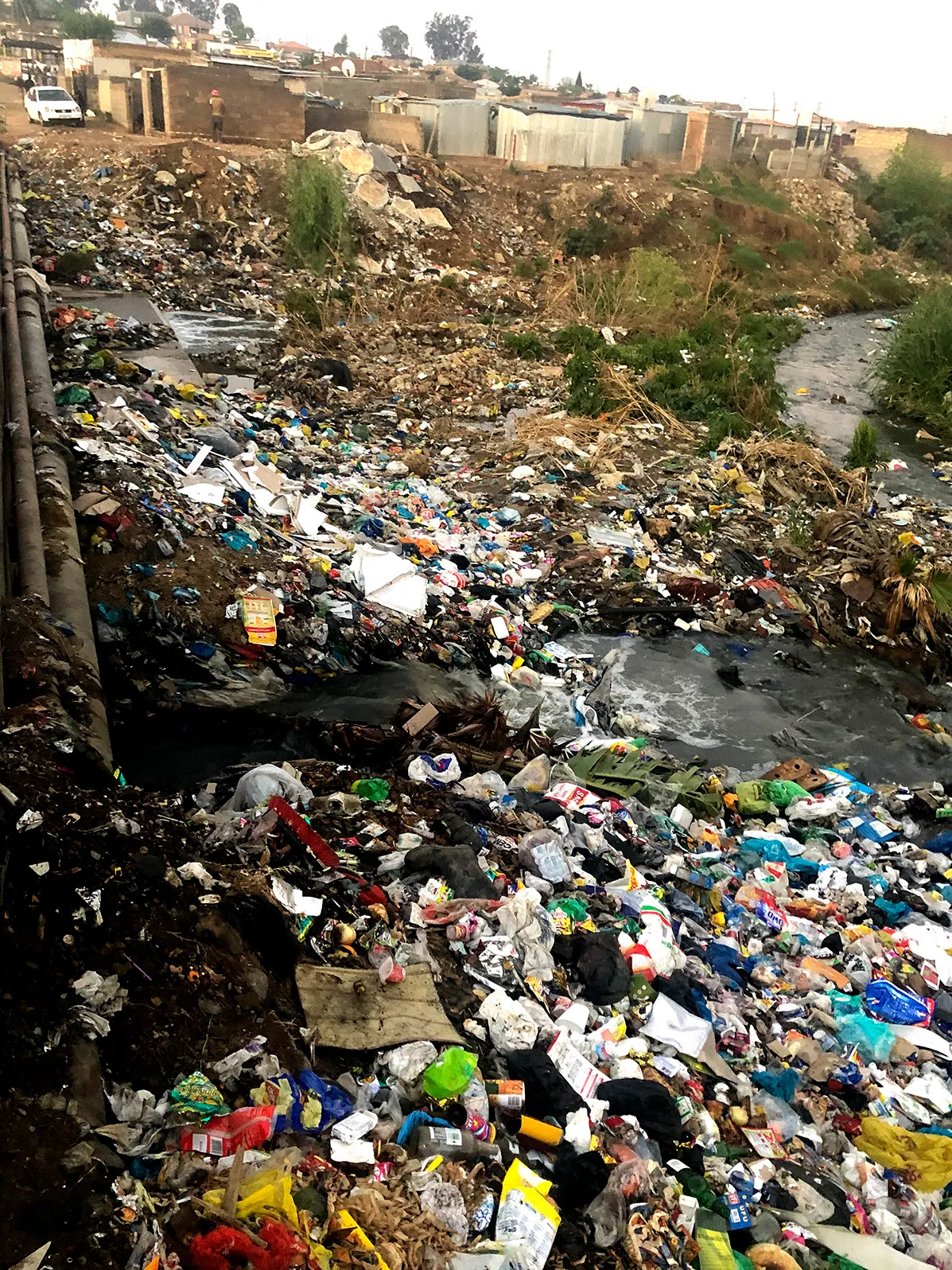
Kaalfontein, Gauteng after the rains. Here massive amounts of household rubbish is surreptitiously dumped off from the bridges. Innumerable sopping bags filled with disposable plastics form huge piles, which harbors large rats and poses grave health hazards to the people. This rubbish is never removed by the council, all gets washed down into the Hennops River below, lining the banks and trees all the way down, slowly turned into toxic microplastics. The banks have been filled up and leveled with building rubble, whole neighborhoods of illegal houses, built in the wetlands, the streams are the only waste removal services for hundreds of thousands of people. (Photo: Willem Snyman)
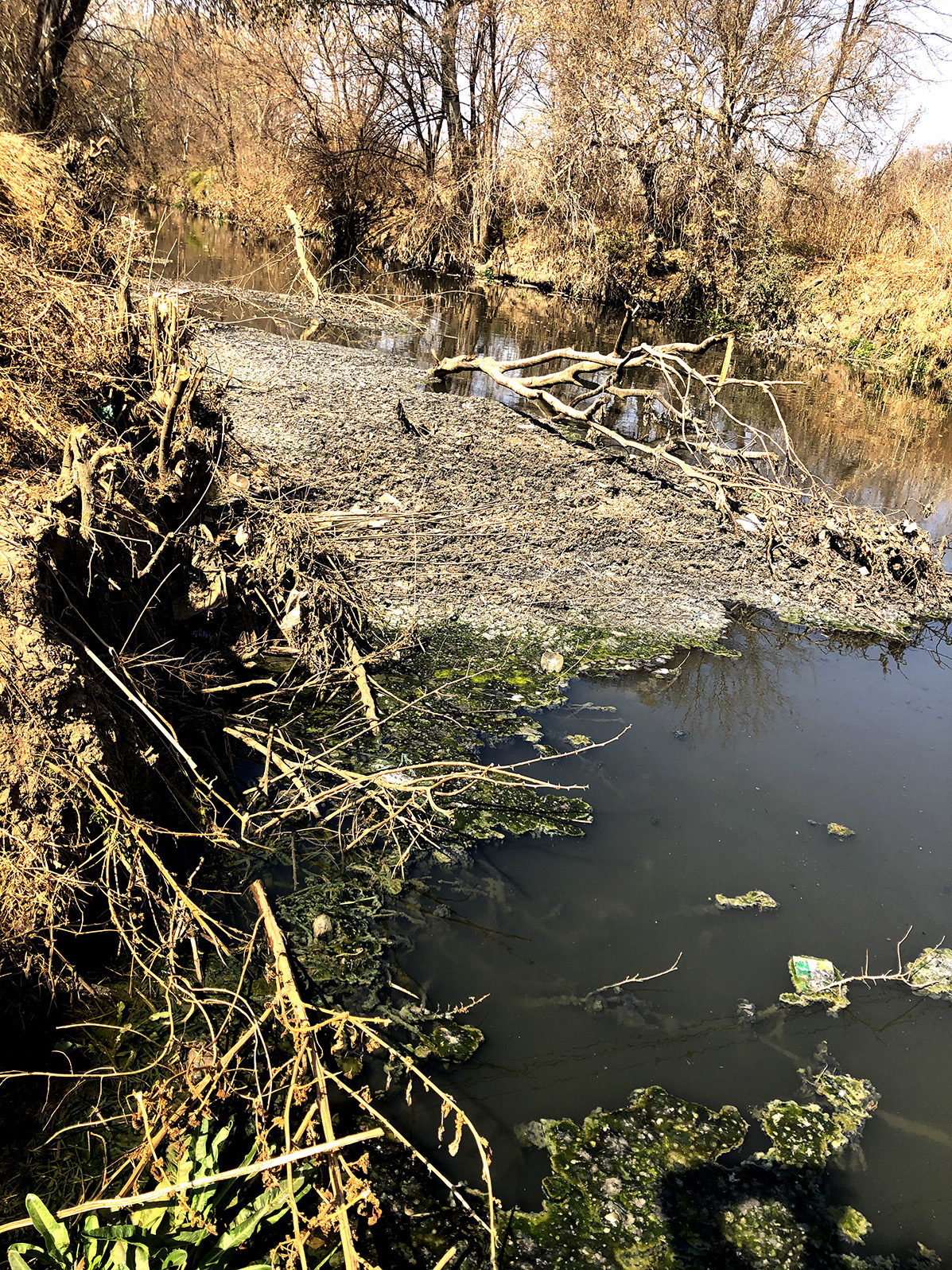
A black Hennops river, Gauteng with floating sewage islands in Mooiplaas, just below the chronically failing Sunderland Ridge Wwtw, most due to cable theft. The Erasmia pump station here was vandalized a year ago and spills raw sewage just above where large-scale irrigation with this takes place on edible crops. Sprayed right on the leaves this poses a huge health hazard to unsuspecting consumers. (Photo: Willem Snyman)
Ongoing devastation
The remaining natural streams and wetlands of Gauteng’s largest cities — Midrand, Ekurhuleni, Madibeng and Pretoria, which form an almost continuous metropolitan area in the heart of Gauteng — have become neglected and forgotten, highly polluted, dangerous no-man’s lands strewn with plastics and overgrown with weeds and aliens, leaving them vulnerable to development and illegal settlements, especially in the flood zones and wetlands, seen as free land.
Many of the original parks were originally laid out around these areas, which should have been the pride and joy of our metropolis. Now they are so polluted and hidden away that few residents are even aware of their existence. In upmarket Sandton, for instance, the most valuable riverine land, the upper flow of the Jukskei River, is fenced off with skull and crossbones signs.
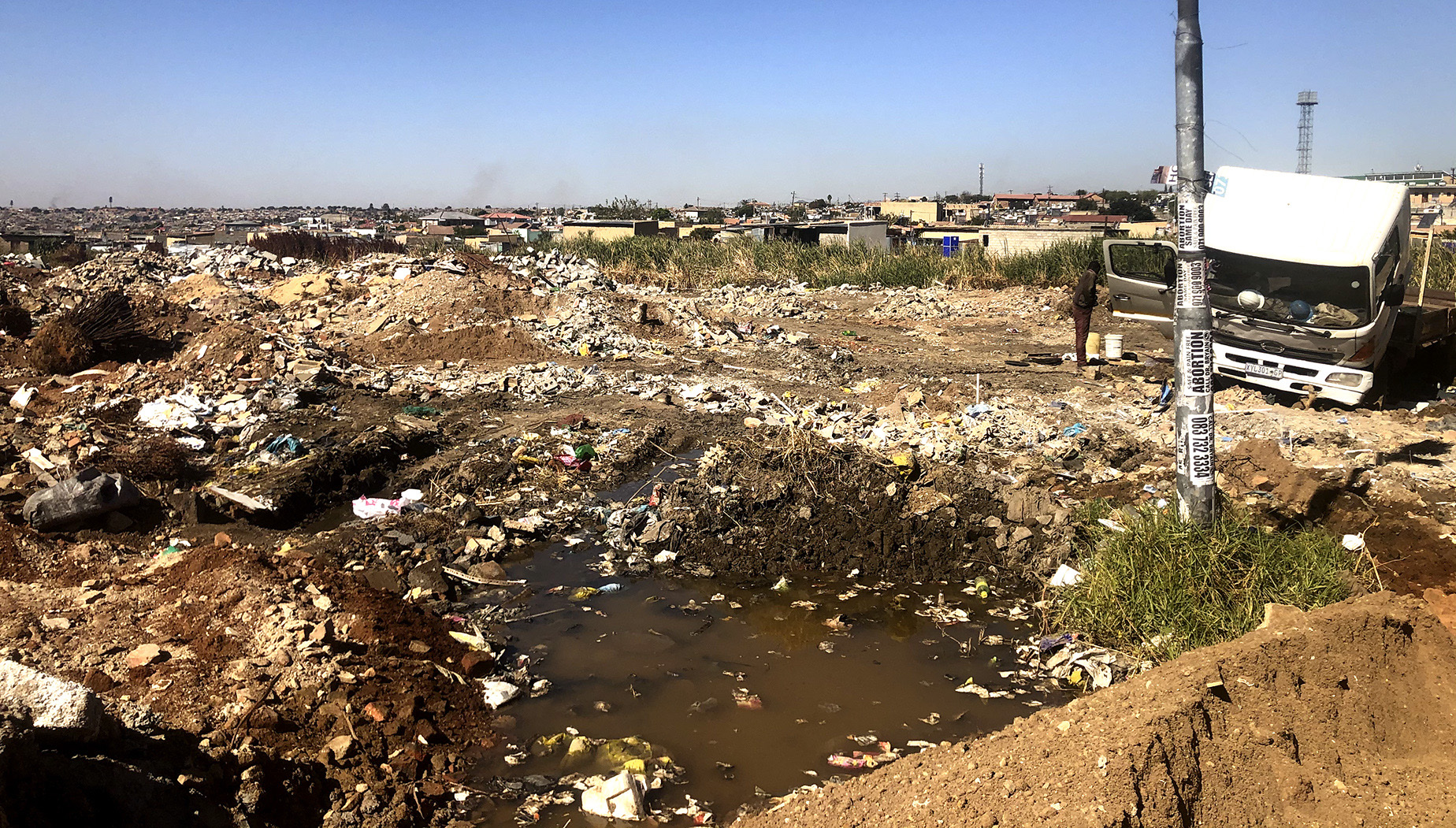
A new dumping and invasion site in the wetland, right near the Kaalfontein, Gauteng, source. Here two years ago, we planted trees and did a cleanup with DWS, the community wanted a children’s park. The large truck got stuck when dumping in this permanently wet soil, filled up and leveled with building rubble for illegal shacks. (Photo: Willem Snyman)
The way forward: Rivers of Origin Reserve
A freshwater sanctuary, with the suggested name of Rivers of Origin Reserve, was proposed a number of years ago by FRESH.ngo, a non-profit organisation that aims to clean up South Africa’s rivers, dams and waterways.
Ideally, the reserve would stretch from the water source areas on the Witwatersrand, incorporating the last natural ridges and connecting reserves like the Walter Sisulu National Botanical Garden and Rietvlei Reserve, through riverine corridors to the large outlying dams mostly built for irrigation. Most of these have existing nature reserves around them, like the Hartbeespoort, Roodeplaat and Bon Accord dams as well as Suikerbosrand Nature Reserve, to name a few.
The proposed area would link up with the recently declared Crocodile River Reserve, which protects the lower flow and confluence areas of the Jukskei, Hennops and Crocodile rivers, in a Gauteng Department of Agriculture and Rural Development (GDARD) reserve to protect these areas of critical biodiversity. The environment here is being threatened by upstream pollution and it would be crucial to extend the reserve status upstream to the sources, to preserve these last biodiversity corridors of our threatened grasslands and their original high biodiversity.
By connecting these isolated nature areas along corridors, gene pools can be strengthened and the Highveld grasslands, probably the most diverse and threatened biome in South Africa harbouring many endemic species, can be saved.
These areas must become major tourist destinations, archaeological and historical zones for hiking, paddling and eco-tourism, so providing healthy enjoyment and giving sustainable employment to many in our most densely populated areas.
This way the healing mineral waters of the Witwatersrand can once again bring life and health to all of us, as they did to our early ancestors. DM/MC/ ML
Willem Snyman is the founder and director of FRESH.ngo. He is also a committee member of Action for Responsible Management of Our Rivers (Armour) and the Crocodile River Reserve unit manager for the Hennops River.














 Become an Insider
Become an Insider
A wonderful initiative and a welcome change from worrying about fossil fuels. Let every family give it their support.